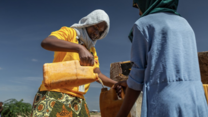Water, sanitation, and hygiene (WASH) programming covers a large proportion of environmental health activities conducted by the International Rescue Committee (IRC). In acute emergencies, beneficiaries need emergency WASH promotion programs that prevent disease and enhance personal safety and dignity. Places recovering from crisis receive support for stronger community and government oversight on water systems and hygiene and sanitation services.
Latrine design is highly depended on local context in all these activities. A wide range of factors—environmental factors, such as ground conditions and availability of materials; community factors, such as population density and access to existing systems; and cultural factors, such as the acceptability of handling human waste and privacy requirements—are necessary to consider when the choice of sanitation system is made. These factors play a role in technical design decisions, including whether to use a dry or water-based system, whether to use an underground or raised pit/storage tank, and whether to use a squatting or sitting user design.
This analysis examines the cost efficiency of WASH activities in Ethiopia, mainly:
- Building household latrines that serve individual family units
- Building community latrines in blocks that serve groups of families/the general population
- Rehabilitating old, unusable latrines
- Maintaining existing latrines
This analysis seeks to examine whether there are latrine-building programs that deliver the same output at different costs. If so, what are the drivers of the cost differences? Are there features of programs that, although they increase cost, also impact the useful life of a latrine? What factors of program design could be modified to improve cost efficiency?
- The number of people effectively served by latrines depends on the usable life of those latrines and how well they are maintained. This suggests that maintenance and promotion costs should be considered as part of the ‘infrastructure’ of latrines when calculating the costs.
- The cost efficiency of programs in this analysis has a wide range that is driven by differences in materials, labor, and maintenance costs. The cost per person-year of latrine access achieved ranged between $5 and $113, with a median of $44. Implementation staff costs were relatively consistent across programs, with a significant difference in the proportion spent on materials, labor, and maintenance costs across programs.
- Scale is important. Because of the ‘fixed’ nature of program management costs, large scale (in terms of quantity of latrines built within a program) latrine-building efforts made programs cost much less per person-year of access achieved.
- Spreading program shared costs over a greater number of activities improves efficiency. The more activities shared across a program’s fixed costs, the more cost efficient activities become, especially when activities are complementary such as latrine building and maintenance.



